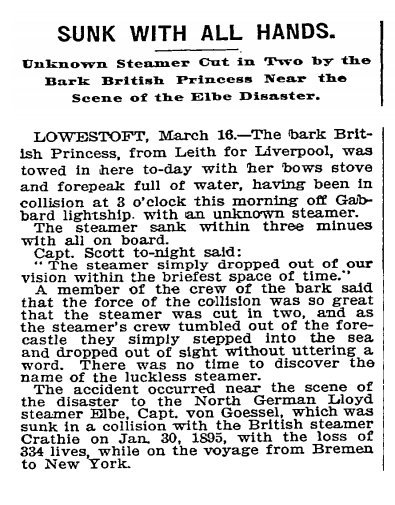Sunk with All Hands
In 1898, while en route from Leith to Liverpool, the British Princess under the command of Robert Crawford Scott was involved in a collision with an unknown steamer. The steamer sank immediately, and there were no survivors.
Gugliemo Marconi was still developing his apparatus which would allow wireless communication, but in 1898 ships had three options for signalling each other – flags (when visiblity allowed), lanterns (at night), and shouting when all else failed. Approaching each other head-on at night with the sailing vessel making good progress under a following wind, there was little that could have been done to avoid disaster.
The New York Times reported:-

In the days which followed more details emerged. Robert gave a harrowing account of events:
The Evening Star, Ipswich, March 17th, 1898
|
COLLISION AT SEA. INTERVIEW WITH THE BARQUE’S CAPTAIN. The captain of the British Princess, in an interview with representative of the “Eastern Daily Press”, said: The barque is an old ship, having been built some thirty years, and is owned Messrs. Gracie, Beazley, and Co., of Liverpool. This morning, after midnight, whilst I was in my berth, I was awakened by the sound of a collision. I immediately went on deck. The weather was fair, all our lights were burning, and the wind was in a south-westerly quarter, with no heavy sea. We were somewhere off the Gabbard Light, which is near Orford Ness, when the collision occurred. The steamer which had run into us went out of sight like a breath upon the air. She simply dropped out of our vision within couple of minutes of the impact. I heard just one voice, a sort of murmur, and that was all. I at once took steps to ascertain our damage. There is a large hole on either side of our bows, through which the water poured with great volume. Our fore peak is full of water. The boats were swung out in readiness for any emergency that might arise, but in the darkness nothing much could done. It was not till daylight that the full extent of the damage could be ascertained. At about one o’clock in the afternoon, the tug Oceana was sighted, and she brought us in tow to Lowestoft. We were about twenty miles off this port when picked up.” PROBABLE IDENTITY OF STEAMER. No news has been received at Lowestoft to-day of the steamer sunk through collision with the Liverpool barque British It thought, however, she may have been a Norwegian steamer for Billingsgate with herrings, as a message reached Lowestoft to-day asking if the vessel was the Reservine, which was due at Billingsgate last evening. There nothing to identify ill-fated steamer, and no information can therefore be given. |
Eleven days later and the identity of the unfortunate steamer was suspected:-
Sunderland Daily Echo and Shipping Gazette, March 28th, 1898
|
THE BRITISH PRINCESS COLLISION. SUPPOSED LOSS OF NINETEEN LIVES. A West Hartlepool correspondent states that it is feared that the vessel run down by the British Princess on the 16th inst. Is the steamer Magnet, formerly owned at that port, but sold to foreign owners. She was under the command of Capt. Buchholtz. The Magnet was bound from Pomaron for Stettin with iron ore, and about the time of the collision was spoken off Dungeness. Since then she has not been heard of. The description given by the captain the British Princess of the vessel he collided with agrees with that of the Magnet, which carried nineteen hands. |
Finally, two and a half weeks after the accident, came confirmation:-
Leeds Mercury, April 4th, 1898
|
THE BRITISH PRINCESS COLLISION. The statement that the steamer which sank after collision with the British Princess was the Magnet, formerly named the E.S. Jobson, has been confirmed. She was in charge of Captain Paul Buckholtz, of Konigsberg. His brother arrived in Lowestoft on Saturday and on being shown the wreckage which was found wedged in the bows of British Princess, he unhesitatingly declared that it belonged to the Magnet. She carried a crew of eighteen all told. |
Many thanks to Gary Green and Sandra McKay of Hartlepool Library Services for providing this information.